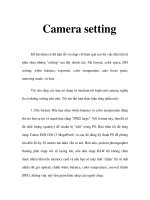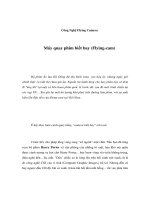E06 camera focal length
Bạn đang xem bản rút gọn của tài liệu. Xem và tải ngay bản đầy đủ của tài liệu tại đây (1.1 MB, 8 trang )
Camera Basics
Camera focal length
Focal length is the distance measured from the center of the lens to the camera sensor, in other
words the focal length of the lens tells us how much magnification the lens achieves.
An example to make it easy for you to understand: You have a 40mm lens and you can see a
mountain in the distance, but if you have a 400mm lens, you can only see the mountains. the tree
on that mountain.
Meaning: The focal length of the camera determines the range of scenes that you can capture,
like the example we talked about above, the shorter the camera focal length, the wider the
camera angle. And the longer the focal length, the larger the distant object will appear.
Types of popular lenses today
The focal length of the lens is clearly marked on the body of the lens. The focal length will tell
the photographer the shooting angle of the lens that we often call such as wide-angle lenses,
telephoto lenses, etc. At the same time, the focal length also tells you the magnification level of
the subject. body in the photo.
Lenses are divided into several categories:
Lenses with a focal length of about 35mm are called ordinary lenses.
Lenses with focal lengths less than 35mm are called wide-angle lenses.
Lenses with a focal length greater than 35mm are called telephoto lenses.
And there are no strict standards for these terms either. Using different lenses depends on the
subject or the image you want to capture.
All lenses have a focal length marking on the lens body and that's what the lenses are called.
Example: 18-55mm f/3.5-5.6 – from this name you can tell this is a very wide lens that can take
wide-angle shots at the focal length of 18mm and the longest zoom with a focal length of 55mm.
. In addition, there are also lenses with only 1 fixed focal length such as the 55mm f/1.8 lens.
Lenses that can change focal length are called zoom lenses, and lenses with only one focal length
are often called primes, or primes.
Classification of focal ranges
Once you understand camera focal lengths, you'll know what focal length to choose for your
photos. We would like to share the classification of focal ranges in each common use case (crop
sensor focal length)
Landscape photography: from 10mm to 18mm
Full body portrait: 24mm to 45mm
Portrait: 55mm to 140mm
Night exposure: 10mm to 18mm
Macro photography: 70mm to 150mm
Family and kids shots: 35mm to 90mm
Outdoor sports shooting: 200mm to 400mm
Focal length and crop factor
Using a camera with a Crop sensor like the Nikon D5300, Canon 7D, or Sony A6000, etc., when
shooting at the same focal length, the image will have a narrower angle of view than when
shooting on a Full-frame sensor camera. For example, when you shoot a 35mm lens on a crop
sensor camera, the angle of view will be the same as when you shoot a 50mm lens on a fullframe sensor camera at the same distance.
That is, when you look at the 50mm lens on a crop camera, it's the same as the 85mm lens on a
full-frame camera. Full-frame and crop cameras each have their own pros and cons, and that
doesn't mean a full-frame camera is better than a crop. This also depends on your needs.
The basics you need to know about camera focal length
1. Focal length is not as important as field of view
There are two factors that determine the field of view of a lens: focal length and sensor size. The
field of view, sometimes called the angle of view, is much more important than the focal length,
because it tells you how much of the scene the lens "sees".
However, since the field of view varies depending on the sensor size, manufacturers give us
alternative information through focal length measurements. Focal length is a fixed measurement
that does not change (it is the distance from the center of the lens to the focal plane, i.e. the
camera's sensor).
2. Wide-angle lenses are lenses for “retraction”
Any lens with a field of view wider than 63 degrees is a wide-angle lens. Those are usually
35mm or shorter tubes on full-frame cameras.
Wide-angle lenses have two characteristics that affect the shot:
– Wide field of view means you have to move closer to your subject to bring it into the frame.
But, at the same time, the wide-angle lens will also capture less of the background. The shorter
the focal length, the larger the background and the closer you have to the subject.
– Wide angle lenses generally provide better depth of field at any aperture setting than longer
focal lengths (in fact, the distance from the lens to the subject needs to be adjusted depending on
the focal length. ).
3. Telephoto lenses are lenses to “exclude”
Why is it said that a telephoto lens is an exclusion lens? They have a narrow field of view. When
you bring your subject into the frame, the background is barely visible. They also easily get the
background out of focus when using a wide aperture.
4. Normal lenses keep the middle position
Conventional lenses have a field of view of about 55 degrees, which holds the middle position
between wide-angle and telephoto lenses. They don't give the image the dramatic angle of view
you can get with a wide-angle lens, and they don't exclude the background to the same extent as
a telephoto lens.









